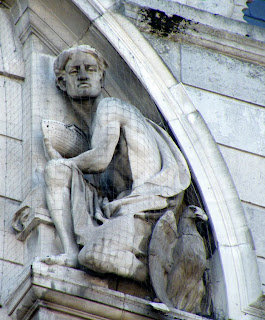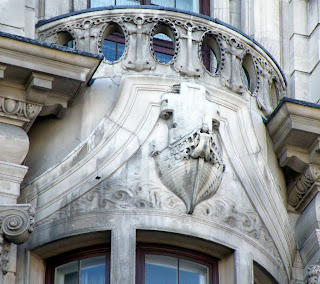
Cockspur Street was where you went to buy a ticket on an ocean liner. All the famous names were there including, up to 1914, the German Hamburg America Line, whose flagship
Deutschland held the Blue Riband for the fastest transatlantic crossing in the first few years of the 20th century.
Hamburg America Line built one of the grandest buildings on Cockspur Street in 1906, to the designs of A.T. Bolton and featuring a riot of sculpture by William Bateman Fagan.

During the First World War, Fagan worked with Francis Derwent Wood at the 3rd London General Hospital making facial masks for disfigured soldiers and sailors. At the end of the war, his magnum opus at Cockspur Street was seized as reparations and presented to P&O. Nowadays, the tenant is the Bank of Scotland but you can still see the P&O logo carved in the piers between the windows on the attic storey above the entablature. If you look very carefully, behind the logos are the ghosts of the letters HAPAG, for Hamburg-Amerikanische Packetfahrt-Actiengesellschaft.

The bay over the office entrance is emphasised by an ornate bay window and a complex pedimented affair that was originally the base for a stone lantern. At the top is a monstrous head of Neptune with a long flowing beard merging into a diving eagle carrying a fish in his beak. To left and right, merfolk hold sceptres.

Under the curved, broken pediment are two figures symbolising the great liners. On the left, a woman wearing an uncomfortable-looking embossed metal corset holds a model liner
[the Deutschland herself - see comments]. A cherub kneels by her side holding an anchor. On the right,a man holds another ship model
[the Amerika] but he is comfortably swathed in a cloak. An eagle perches beside him.
Below, the bay window is topped by a carving of a ship's bow with a stylised bow wave. The figurehead is a mermaid holding on to the beakhead, her bifurcated tail snaking through the timbers. It has to be admitted there is something rude about a mermaid with two tails. Starbucks used one as its original logo but changed it after protests from public decency lunatics.
The three bay windows are decorated with reliefs of Greek gods carved by Fagan, each flanked with boys riding either dolphins or hippocamps.
On the left is Dionysos, the god of wine, in a ship with a lion. According to Homer, Dionysos was kidnapped by pirates who wanted to sell him into slavery, believing his exceptional good looks would fetch a high price. He turned himself into a lion, and all the pirates leapt overboard. Mercifully, he turned them into dolphins.
The other panels are of Europa and her bull (the god Zeus, who today would be on all sorts of registers) and Icarus flying too close to the sun.
This is interesting. Here is a shipping line in 1906 depicting the world's first fatal flying accident in stone, just as aeroplanes were coming in - the Wright brothers had flown in 1903. Flying was
the hot topic at the time - did HAPAG see the writing on the wall for ocean liners?
When P&O took over Hamburg America Line's building in 1918 as part of Germany's reparations for the war, the company lost no time adapting it for their own use. The ground floor booking hall was completely revamped, and the entrance marked with an extraordinary bronze relief by Ernest Gillick.
The theme of a pair of figures representing each end of the liners' routes is repeated, but this time they are caryatids symbolising Britain on the right and the Orient on the left. A pair of putti repeat the theme, one holding Britannia's trident and the other a lotus flower. They stand confidently on ship's yards.
At the centre is a rising sun with P&O's motto Quis Separabit (from Romans 8:35 and the motto of several British regiments).
I love the way that Britannia stands in a strong, confident but no-nonsense stance, whereas the dusky oriental lovely has a slight but sensuous swing to the hips.
Thanks to Beth Ellis of the P&O Heritage Collection for her help.